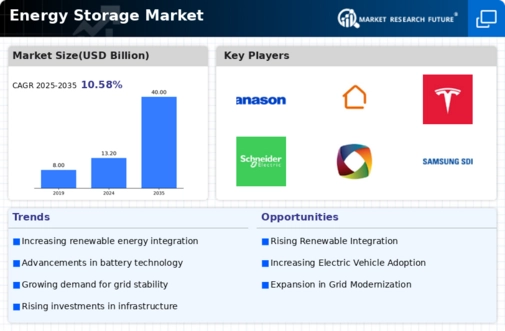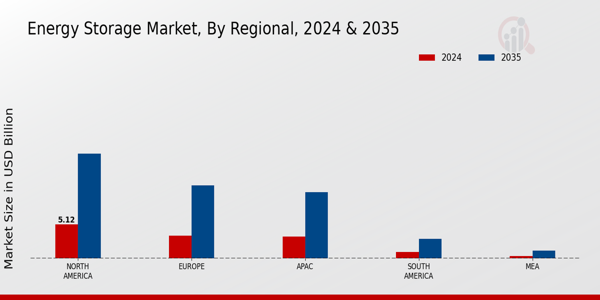Market Trends and Projections
The Global Energy Storage Market Industry is characterized by dynamic trends and projections that indicate substantial growth in the coming years. With a market value of 13.2 USD Billion in 2024, the industry is on a trajectory towards reaching 40 USD Billion by 2035. This growth is driven by various factors, including technological advancements, government policies, and increasing demand for renewable energy. The anticipated CAGR of 10.58% from 2025 to 2035 suggests a robust expansion phase, highlighting the importance of energy storage in the global energy landscape. Charts illustrating these trends and projections can provide valuable insights into the market's future trajectory.
Rising Electric Vehicle Adoption
The rise in electric vehicle (EV) adoption is significantly influencing the Global Energy Storage Market Industry. As more consumers transition to electric vehicles, the demand for efficient energy storage solutions is increasing. EVs require robust charging infrastructure, which often relies on energy storage systems to manage energy flow and support grid stability. This interconnection between EVs and energy storage is fostering innovation and investment in both sectors. The anticipated growth in the energy storage market, with a projected CAGR of 10.58% from 2025 to 2035, reflects the potential for synergies between electric vehicles and energy storage technologies.
Government Incentives and Policies
Government policies and incentives are playing a pivotal role in shaping the Global Energy Storage Market Industry. Many governments worldwide are implementing supportive regulations and financial incentives to promote energy storage adoption. These measures include tax credits, grants, and subsidies aimed at reducing the financial barriers associated with energy storage systems. Such initiatives not only encourage investment in energy storage technologies but also stimulate innovation within the sector. As a result, the market is poised for growth, with projections indicating a value of 13.2 USD Billion in 2024, as governments recognize the importance of energy storage in achieving energy security and sustainability goals.
Growing Demand for Renewable Energy
The Global Energy Storage Market Industry is experiencing a surge in demand for renewable energy sources, driven by the global shift towards sustainability. As countries strive to meet their climate goals, the integration of renewable energy technologies such as solar and wind is becoming increasingly prevalent. Energy storage systems play a crucial role in balancing supply and demand, particularly during periods of low generation. This trend is expected to contribute to the market's growth, with projections indicating a market value of 13.2 USD Billion in 2024, and potentially reaching 40 USD Billion by 2035, reflecting the industry's pivotal role in facilitating the transition to cleaner energy.
Increasing Grid Resilience and Reliability
The need for enhanced grid resilience and reliability is a significant driver for the Global Energy Storage Market Industry. As extreme weather events and natural disasters become more frequent, the vulnerability of power grids is increasingly apparent. Energy storage systems provide a solution by enabling utilities to store excess energy during low-demand periods and release it during peak demand or outages. This capability not only stabilizes the grid but also ensures a continuous power supply, thereby enhancing overall reliability. The growing recognition of these benefits is likely to contribute to the market's expansion, with an expected market value of 40 USD Billion by 2035.
Technological Advancements in Energy Storage Solutions
Innovations in energy storage technologies are significantly impacting the Global Energy Storage Market Industry. Developments in battery technologies, such as lithium-ion and solid-state batteries, are enhancing energy density, efficiency, and lifespan. These advancements not only improve the performance of energy storage systems but also reduce costs, making them more accessible to consumers and businesses alike. As technology continues to evolve, the market is likely to witness increased adoption rates. The anticipated compound annual growth rate (CAGR) of 10.58% from 2025 to 2035 underscores the potential for technological breakthroughs to drive market expansion and reshape energy storage solutions.
























Leave a Comment